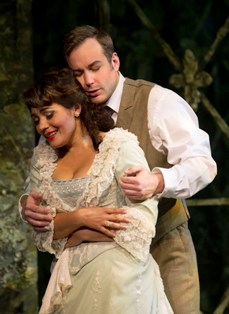
From Cincinnati Opera, With Love
“Standard of excellence,” “regarded as a model worthy of imitation.” These are dictionary definitions of “ideal” (Merriam Webster).

That’s what Cincinnati Opera’s “La Traviata” was Thursday evening (July 26) at Music Hall.
No better leads could have been hoped for than Ailyn Pérez and Stephen Costello as Violetta and Alfredo (both winners of the Richard Tucker Award, by the way). Being husband and wife may not necessarily guarantee credibility onstage, but for this couple, it did. Their interaction was warm and natural, and Pérez’ full, sweet soprano blended beautifully with Costello’s robust tenor. Both displayed fine acting skills, and consonant with today’s visually oriented society, they looked their parts, she petite and lovely, he youthful and handsome.
Baritone Marco Caria was equally convincing as Alfredo’s father Germont, who persuades Violetta to renounce Alfredo to preserve the family name and insure his daughter’s marriageability. Caria projected a character of true feeling, evincing genuine regret for his actions. One could ache for him as he sat despondently in Violetta’s bedroom as she lay dying.
It was a strong, even luxury cast, with mezzo-soprano Stacey Rishoi as Flora (Violetta’s friend); baritone Jonathan Stinson as Baron Douphol (Violetta’s protector); bass-baritone Kenneth Shaw as Marquis D’Obigny (Flora’s protector); mezzo Audrey Walstrom as Annina (Violetta’s maid); and tenor David Cangelosi as Gastone, the young blade who introduces Alfredo to Violetta in act one. Jose Maria Condemi’s stage direction was eminently convincing, with nothing extraneous or contrived to slow things down.
The opera’s indispensable lead was conductor Carlo Montanaro in his Cincinnati Opera debut. The energy and feeling that infused Verdi’s music and kept the cast and the Cincinnati Symphony Orchestra performing at their highest level flowed from his baton, beginning with the Prelude and its touching premonition of Violetta’s death in the last act.
The period production from Lyric Opera of Chicago, lit by Cincinnati Opera’s Thomas Hase, bled blues and greens in act one (Violetta’s house), warming to reds and oranges in the act two gambling scene (Flora’s party), where Alfredo casts his winnings at Violetta’s feet as payment for her services. Act three was dark and shadowy, with Violetta’s death bed bathed in white.
There were many unforgettable moments during the evening. One was Perez’ aria in act one, where Violetta ponders the possibility of true love with Alfredo, then dismisses the thought with declarations of “Sempre libera” (“Always free”). Her transitions were sweet, her coloratura agile and her high C’s thrilling. The confrontation in act two between Violetta and Germont was deeply moving and sadly ironic, with Pérez acceding softly to Germont’s request to forsake Alfredo and Germont (joined by Violetta) responding “May you be happy” in mellifluous thirds.
The ballet at Flora’s party (choreographed by Devon Carney of Cincinnati Ballet) was eye-filling and fun, with gypsies, tambourines and dancers posing as bulls for the “matador” to slay. The entire scene was gripping and moved briskly along, from the party revelers to Alfredo’s denunciation of Violetta, her collapse, the outcry against Alfredo and the Baron throwing down his handkerchief to challenge Alfredo to a duel.
Act three brought the drama to a poignant conclusion. Pérez clothed in white and the mannequin that stood nearby in Violetta’s red party gown made an aching contrast, as did the clamor by Carnival celebrants that arose from the street below her window. Pérez’s faint but focused high notes bespoke Violetta’s illness perfectly, and she and Costello shared Violetta’s final moments, including her brief rush of hope, exquisitely. Again, Montanaro handled the scene’s tension and release with immaculate skill.